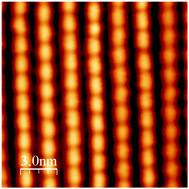Influence of Cu adatoms on the molecular assembly of 4,4′-bipyridine on Cu(111)
Abstract
The formation of highly organized structures based on two ligands with pyridyl functionalities, 4,4′-bipyridine (BPY) and 1,4-di(4,4′′-pyridyl) benzene (BPYB), and Cu adatoms on the Cu(111) surface has been studied with low temperature and variable temperature scanning tunneling microscopy (STM) and first-principles calculations. We show that the formation of a highly organized adlayer built from adatom–molecule and molecule–molecule units strongly depends on the number of mobile Cu atoms on the surface. While a high concentration of Cu adatoms (high adatom/BPY ratio, ≥1) leads systematically to the formation of organometallic nanolines, their absence (low adatom/BPY ratio, ≈0) gives a compact self-assembled molecular network, and more specifically hydrogen-bond networks (HBN) with BPY molecules organized in a T-shaped fashion. Alternatively, an intermediate concentration of Cu adatoms (0 < adatom/BPY < 1) allows the formation of a well-organized and compact structure where both organometallic and HBN components coexist. Although STM images cannot clearly reveal the presence of Cu adatoms within the organometallic moiety, the bonding of BPY to a single or two Cu adatoms can be clearly identified by scanning tunneling spectroscopy (STS), and is supported by Density Functional Theory (DFT) results. Additional STM simulations suggest that the relative position of the Cu adatom with respect to the organic ligands just above has a significant impact on its detection by STM. This study exemplifies the prominent role of metallic adatoms on the formation of a complex organometallic network and should open more rational practices to optimize the formation of these supramolecular networks.



 Please wait while we load your content...
Please wait while we load your content...